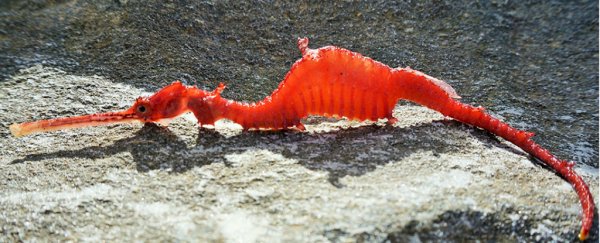A type of seadragon known only from museum specimens has been seen in the wild for the first time in deep water off Western Australia.
Two ruby seadragons were observed for nearly 30 minutes, uncovering new details about their anatomy, habitat, and behaviour.
The researchers from the University of Western Australia, the Western Australian Museum, and Scripps Institution of Oceanography used a mini-remotely operated vehicle in waters more than 50 meters deep near the Recherche Archipelago off Esperance.
Here's the footage:
This latest discovery confirms that ruby seadragons lack ornate leaf-like appendages, a feature that scientists had considered to be distinguishing characteristics based upon the two known species, the common and leafy seadragons.
Both use their leafy appendages as camouflage in seaweed and kelp meadows where they tend to live.
Seadragons are related to seahorses and pipefish.
Last year, Scripps Oceanography marine biologists Josefin Stiller and Greg Rouse, and Nerida Wilson of Western Australia described the previously unknown ruby seadragon from preserved specimens misidentified as common seadragons, one of which was collected nearly 100 years ago.
The researchers believe the ruby seadragon lost its appendages through evolution and that its red colour acts as a camouflage in the deeper, dimly lit waters where it lives.
Whether they evolved a curly tail independently from their pipefish ancestors, or simply retained it while the other seadragons lost it, will require further study.
Nerida Wilson from UWA and the Western Australian Museum says there are so many discoveries still waiting in southern Western Australia.
"Western Australia has such a diverse range of habitats, and each one is deserving of attention," Wilson says.
This article was originally published by Business Insider.
More from Business Insider:
